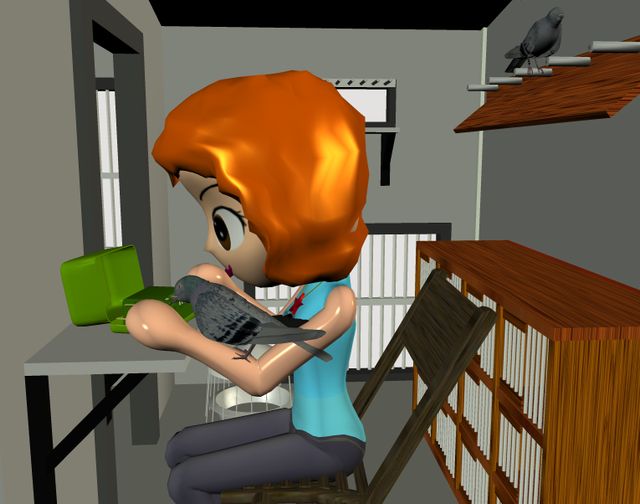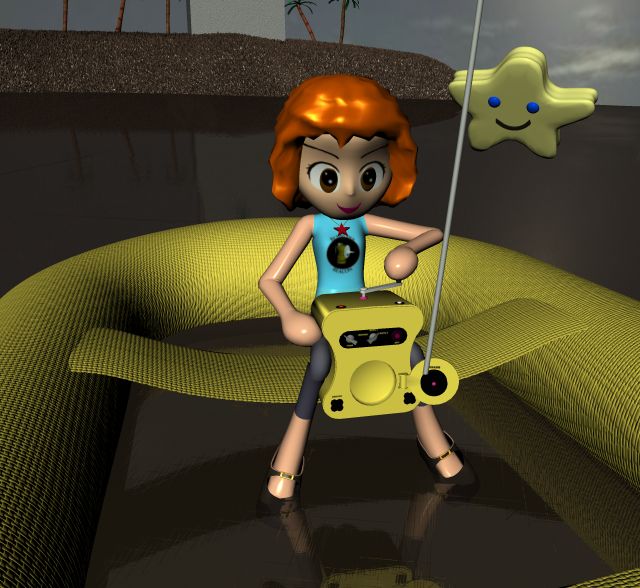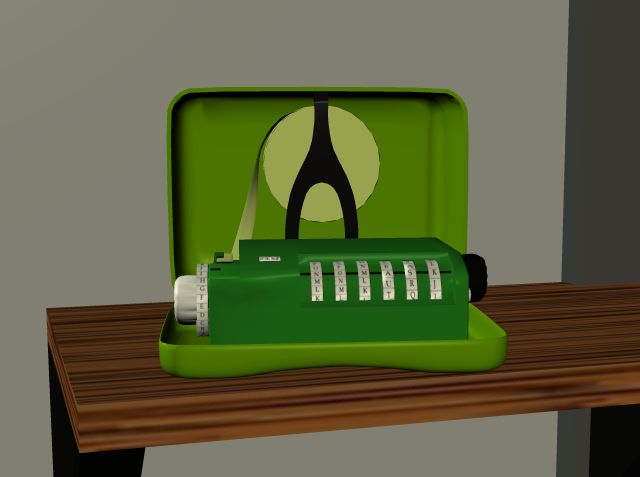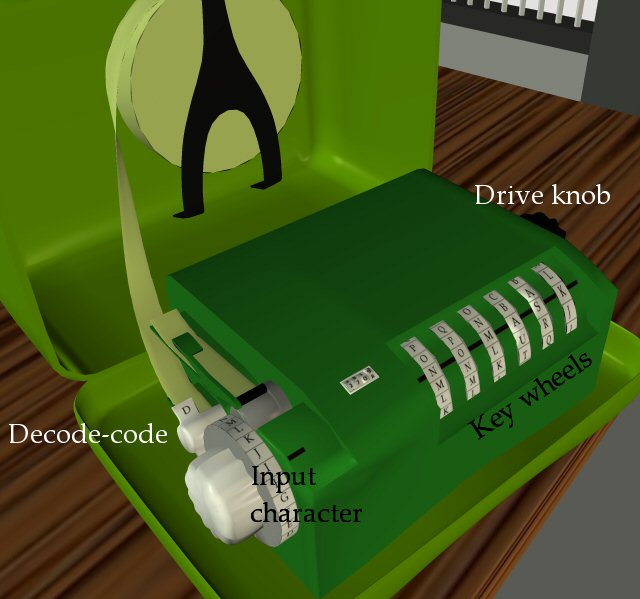Wednesday, July 01, 2020
The Enigma was thoroughly familiar
Starting a new series, Ancestral Encryption. Gotta keep the artistic output flowing, though my heart's not in it today. Way too much holocaustal hell, with no sign of any relief.
 This M-209 ciphering machine was produced in great quantities during WW2. It was a small machine. Though it looks like a typewriter and has the same complexity as an adding machine, it's about the size of a landline phone.
Like the Gibson Girl transmitter,
This M-209 ciphering machine was produced in great quantities during WW2. It was a small machine. Though it looks like a typewriter and has the same complexity as an adding machine, it's about the size of a landline phone.
Like the Gibson Girl transmitter,
 the M-209 was ergonomically designed to fit the soldier's body. It could be used on a desk or table, but it was mainly meant for field use. The case was indented to fit over a knee, and a strap was added to hold it to the leg.
the M-209 was ergonomically designed to fit the soldier's body. It could be used on a desk or table, but it was mainly meant for field use. The case was indented to fit over a knee, and a strap was added to hold it to the leg.
 The six Key wheels on top were usually preset at headquarters before sending it out in the field. The field operator would turn the C/D switch on left to Code or Decode, then turn the Selector on left to each character of the input text and turn the black Drive knob on right. On some versions the Drive knob had a crank. As with a manual adding machine, the Drive knob would run the input letter through the cams set by the six Key wheels, and the output character would be printed on the paper tape.
The six Key wheels on top were usually preset at headquarters before sending it out in the field. The field operator would turn the C/D switch on left to Code or Decode, then turn the Selector on left to each character of the input text and turn the black Drive knob on right. On some versions the Drive knob had a crank. As with a manual adding machine, the Drive knob would run the input letter through the cams set by the six Key wheels, and the output character would be printed on the paper tape.
 The M-209 was a lot like the German Enigma machine, which is famous through stories and movies. Both were based on an earlier commercial cipher machine. Stories and movies give the impression that Alan Turing was solely responsible for solving the Enigma from scratch. Turing's math probably helped, but this class of machine was common on both sides, and familiar long before the war. The British deciphering project didn't use computers or theoretical math; it just manufactured a huge number of simulator machines and ran them in mass production style, bruteforcely examining all possible combinations and permutations. When a correct key was found, the key was applied to new messages until it failed. The project was a triumph of industry and organization, not a triumph of theory.
The M-209 was a lot like the German Enigma machine, which is famous through stories and movies. Both were based on an earlier commercial cipher machine. Stories and movies give the impression that Alan Turing was solely responsible for solving the Enigma from scratch. Turing's math probably helped, but this class of machine was common on both sides, and familiar long before the war. The British deciphering project didn't use computers or theoretical math; it just manufactured a huge number of simulator machines and ran them in mass production style, bruteforcely examining all possible combinations and permutations. When a correct key was found, the key was applied to new messages until it failed. The project was a triumph of industry and organization, not a triumph of theory.
 This M-209 ciphering machine was produced in great quantities during WW2. It was a small machine. Though it looks like a typewriter and has the same complexity as an adding machine, it's about the size of a landline phone.
Like the Gibson Girl transmitter,
This M-209 ciphering machine was produced in great quantities during WW2. It was a small machine. Though it looks like a typewriter and has the same complexity as an adding machine, it's about the size of a landline phone.
Like the Gibson Girl transmitter,
 the M-209 was ergonomically designed to fit the soldier's body. It could be used on a desk or table, but it was mainly meant for field use. The case was indented to fit over a knee, and a strap was added to hold it to the leg.
the M-209 was ergonomically designed to fit the soldier's body. It could be used on a desk or table, but it was mainly meant for field use. The case was indented to fit over a knee, and a strap was added to hold it to the leg.
 The six Key wheels on top were usually preset at headquarters before sending it out in the field. The field operator would turn the C/D switch on left to Code or Decode, then turn the Selector on left to each character of the input text and turn the black Drive knob on right. On some versions the Drive knob had a crank. As with a manual adding machine, the Drive knob would run the input letter through the cams set by the six Key wheels, and the output character would be printed on the paper tape.
The six Key wheels on top were usually preset at headquarters before sending it out in the field. The field operator would turn the C/D switch on left to Code or Decode, then turn the Selector on left to each character of the input text and turn the black Drive knob on right. On some versions the Drive knob had a crank. As with a manual adding machine, the Drive knob would run the input letter through the cams set by the six Key wheels, and the output character would be printed on the paper tape.
 The M-209 was a lot like the German Enigma machine, which is famous through stories and movies. Both were based on an earlier commercial cipher machine. Stories and movies give the impression that Alan Turing was solely responsible for solving the Enigma from scratch. Turing's math probably helped, but this class of machine was common on both sides, and familiar long before the war. The British deciphering project didn't use computers or theoretical math; it just manufactured a huge number of simulator machines and ran them in mass production style, bruteforcely examining all possible combinations and permutations. When a correct key was found, the key was applied to new messages until it failed. The project was a triumph of industry and organization, not a triumph of theory.
The M-209 was a lot like the German Enigma machine, which is famous through stories and movies. Both were based on an earlier commercial cipher machine. Stories and movies give the impression that Alan Turing was solely responsible for solving the Enigma from scratch. Turing's math probably helped, but this class of machine was common on both sides, and familiar long before the war. The British deciphering project didn't use computers or theoretical math; it just manufactured a huge number of simulator machines and ran them in mass production style, bruteforcely examining all possible combinations and permutations. When a correct key was found, the key was applied to new messages until it failed. The project was a triumph of industry and organization, not a triumph of theory.Labels: Patient things
